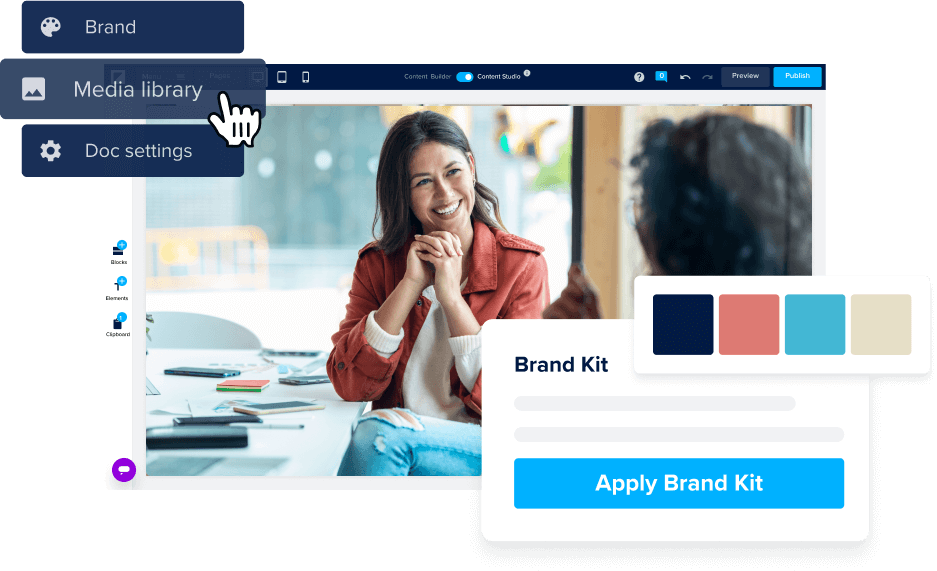How memorable is your content?
We're bombarded by information from the moment we open our eyes (and no doubt check our phones) to when we shut down for the day (probably accompanied by our 5G friend, perched patiently on the bedside table).
Getting your target audience to click on your article vs. another's is a challenge. And once you've got them past that first post, you’ll need to keep them reading and include the written and visual content that creates a lasting impression.
This article reveals some tried and tested tactics for crafting more memorable content. We’ll explore winning formulas for headlines that capture attention and top tips on creating visual and textual content that keeps them hooked until the end. We’ll also look at delivering content that genuinely resonates with your audience and makes them feel something.
Now that we have piqued your curiosity with our headline and drawn you in with an impactful intro, let’s begin!
Nail the headline
Ah, the elusive perfect headline. Even when you have created a killer blog with a CTA QR code that’s guaranteed to get those leads flocking to your contact page, the right headline can still cause a content roadblock.
Here are some ideas to get you started:
- Create a sense of urgency or fear of missing out. For example, “Don’t miss this chance to discover the latest content advice for boosting your SERPs.”
- Include the benefit. For example, “Discover how to craft a headline that drives engagement.”
- Provoke action. “Download the essential guide to crafting memorable B2B content.”
- Use numbers. “10 content marketing trends you need to know for 2022.”
- Get the length right. The length of your headline needs to be 60 characters long or less to feature in its entirety on Google’s search listings. In terms of human consumption, the length shouldn’t be overly long, but it should explain what the reader will get as succinctly as possible. Always make headlines unique, and don’t forget to include your focus keywords!
- Use words that will create an emotional response. This approach should spark curiosity and encourage your reader to click. Words like mind-blowing and inspiring can appeal to people who are looking for impactful content. If your content is all about promoting trust, words like proven and foolproof are good choices.
- I once read a tip to write at least 25 headlines before choosing one. I've done this for years, and I almost always end up choosing one of the last 5 I write.
- I'm a big fan of CoSchedule's headline analyzer. It's a convenient tool that rates your headline on the factors above and then gives you suggestions on how to improve. It's still just a tool, though, and no replacement for clever ideas.
Craft an impactful introduction
People tend to scan articles before settling down to read them. They want to be sure that the article will deliver what it promised in the meta description, on the newsletter summary, or the social media call to action. However, they're pretty likely to read the first sentence or two, so you’ve got to make it count.
Here are some tips for attention-grabbing intros:
- Start with a question. This is a great writing device to encourage your reader to imagine themselves in the situation. For example, “Have you ever wondered what it takes to craft genuinely memorable content?” or “Is it just me, or is most content out there not worth the pixels it is published on?” could be the hook that gets your reader wanting to know more.
- Add a tempting teaser. For example, “Many marketers wonder why their blogs aren’t getting sky-high rankings on Google. The answer is often much stranger than you’d think.”
- Share a recent statistic. This is a tried and tested favorite among content marketers. So, while it is a successful tactic, it is also in danger of being overused. Don’t let this put you off altogether, but make sure your stat of choice is:
- Genuinely relevant to the article
- Taken from recent research
- From a very authoritative, trusted source
- Something the reader isn’t likely to have heard about a dozen times already.
4. Go against the grain. We’d never recommend being controversial for the sake of it. But crafting an opening statement that challenges accepted wisdom and introduces your reader to ideas outside their echo chamber can draw them in.
5. Be empathetic. Humans want to know that other people understand us and feel our pain. If it feels like the right tone for your content, include an opening sentence showing you empathize with your reader’s challenges. For example, “We’ve all been a little stuck for content ideas from time to time, but that needn’t stop us in our tracks.”
Be original
With 4.4m blogs published every day across all platforms, marketers can’t be expected to reinvent the wheel every time they put content out there. However, you should always do your best to choose content themes that haven’t been covered by every single one of your competitors, citing the same tired research and coming from the same old point of view. Not only does that make it likely to slip right out of your reader’s memory, but it also seriously diminishes your efforts to be an authority in your area of business.
Be confident writing in your own tone of voice, don’t try to emulate your competitors, and stick to the copy guidelines outlined in your brand tone of voice documents.
Decide what your unique take on a subject is, and don’t be afraid to try something new.
Include great visual content
Visual assets such as photos, illustrations, videos, graphs, and so forth can make or break the memorability of an article. Here are some dos and don’ts for crafting visual content that sticks.
Dos
- Include interactive elements. This is a great tactic for both visual and textual engagement. So much so that we have given it its very own section, right after this part.
- Make the images part of the whole narrative. The visuals should enhance the story from start to finish. They can help explain complex elements, lighten up areas where the subject matter is getting a bit weighty and serious, break up the text, and generally add some color to the content — literally and figuratively.
- Use visuals that are representative of your audience. For example, choose photos that reflect the cultural diversity of your customer base and visual references that will resonate with your target group.
Don’ts
- Use the same old stock images. A group of suited and booted young execs pointing at a whiteboard or another woman eating a salad will not — repeat, will not — result in a positive, memorable experience for your reader.
- Don’t go for style over substance. The visual content must earn its place on the page and boost the content’s message. If they distract from the content, it won’t be memorable.
- Don’t use visual content that isn’t optimized for mobile.
Include interactive elements
Interactive elements help to stimulate the reader’s senses and boost engagement and recall. An eBook that contains loads of important insights and useful information could fall flat without some entertainment value. Rather than reduce the educational value of the content, the right interactive elements can actually improve it.
Reader attention is triggered by the stimulus included in the content and their ability to remember it is enhanced. By encouraging the reader to actively participate, you put them in the position of protagonist in the narrative rather than a passive consumer of the content.
Gamification of B2B content can be a little risky, but interactive quizzes, questionnaires, solution finders, and checklists could make your content more memorable.
Calculators are also a good addition to the interactive content arsenal especially if they have an added benefit such as ‘find out how much you could save…’ Interactive maps with geolocation data also add an interesting interactive storytelling element to your content.
No matter what interactive elements you choose, always keep your customer personas in mind. What type of interactive media will they respond to, what device will they consume it on, and so forth? Your content must perform well on all devices. If you are considering using interactive media, you’ll benefit from a content creation platform like Foleon’s, which provides a media-rich, fully-responsive user experience.
Curious to see examples of what other businesses are doing to push the limit with interactive content? Check out examples here.
Encourage your audience to think for themselves
We mentioned the importance of involving your reader in your content in the above section on interactive elements. A passive content consumer is much less likely to engage with the content in a meaningful way, and therefore the information probably won’t stick around in their memory for very long.
The aforementioned interactive quizzes and suchlike are good tactics for encouraging your reader to think for themselves. You can also structure your arguments around situations your target audience is familiar with, then ask open-ended questions about how they would manage a situation and encourage them to imagine what the outcomes might be. Make it clear what is at stake, and don’t be afraid to ask provocative questions.
Make them feel something
Think about your favorite movies, songs, and books. The ones that made a lasting impression. They made you feel something, right? Perhaps they reduced you to floods of tears or left you feeling inspired, terrified, joyous, disgusted, or full of the joys of spring. And that meant they stuck in your memory.
To create a meaningful connection with your reader, you need to make them feel something. Try putting yourself in your audience’s shoes. What kind of messages would elicit the desired response in them? If you want them to share the article, include some content that will make them happy or will make them want to connect with their peers. If appropriate, try to make them laugh or do something unexpected.
All these tactics will ensure your content not only earns a valued spot in their memory bank but should also boost conversions. Customers tend to buy with their hearts rather than their heads. In fact, a study by the Institute of Practitioners in Advertising revealed that out of 1,400 successful ad campaigns, the content that contained purely emotional messaging performed twice as well as the content with a rational message.
Learning from your analytics
If you can hone your messaging and choose images that will create a real, lasting connection with your reader and choose a format that they will enjoy and remember, you should be on to a winner.
Keeping a close eye on your analytics will help ensure you are on the right track. Time on page links clicked and so forth. Don’t forget that Foleon’s content creation platform has baked-in analytics that can track a variety of valuable marketing metrics such as opens, page-by-page content views, shares, and forwards.
If you would like to find out more about how this handy tool can help you optimize your messaging, improve your customer journey, and much more, request a demo today.
Discover: Syncing Marketing and Customer Success: The Path to Winning the Customer Journey



